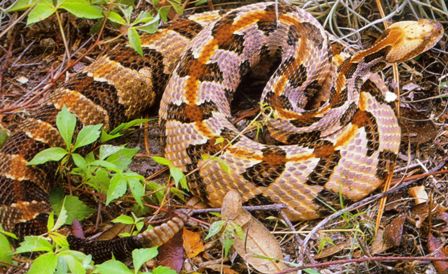Discover Florida Nature
It's time to explore the natural Florida


|
|
|
|
|
 In
Florida, the Timber Rattlesnake is often called the Canebrake Rattler.
The Canbrake Rattler belongs to the light-colored, southern race of
Crotalus horridus. This snakes favorite habitat is the slopes
leading to creeks running through hardwood forests. The Timber
Rattlesnake is not as aggressive as the
Diamondback. This viper
will usually try to slither away when approached, but if it is stepped
on on, the Timber Rattlesnake will probably strike. The venom of the
Timber rattlesnake is potentially lethal! In
Florida, the Timber Rattlesnake is often called the Canebrake Rattler.
The Canbrake Rattler belongs to the light-colored, southern race of
Crotalus horridus. This snakes favorite habitat is the slopes
leading to creeks running through hardwood forests. The Timber
Rattlesnake is not as aggressive as the
Diamondback. This viper
will usually try to slither away when approached, but if it is stepped
on on, the Timber Rattlesnake will probably strike. The venom of the
Timber rattlesnake is potentially lethal!The adult Timber or Canebrake Rattlesnake is usually 36-60 inches long, with the record being 74.5 inches. Males get larger than females. The reddish brown stripe running down the center of the back is disrupted by a series of large, black, chevron-like crossbands on the pinkish gray or tan body. The tail is uniform black. The head is large and sometimes with a dark diagonal line through the eye or just behind the eye. The pupil is vertical and catlike. The tail of the Canebrake Rattlesnake ends in a rattle. Juveniles resemble adults, but with a single rounded button at the tip of the tail. All five of Florida's deadly pit vipers, including the Timber Rattlesnake can be recognized by their stocky bodies, relatively small necks, large triangular heads, and eyes with vertical slit pupils. Like all pit vipers, the Canebrake Rattlesnake has a deep facial pit between the nostril and the eye. The facial pits are extremely sensitive heat-detecting organs, with which the rattler can home in on warm blooded prey. The pit organs can detect differences in temperatures as small as three one-thousandths of a degree centigrade! Pit vipers produce a hemotoxic venom that destroys the blood cells of both warm-blooded and cold-blooded animals. Since there is a pit on each side of the face, they function stereotypically. the pits, working together with the incredible olfactory sensitivity of the snakes tongue, lead the snake unerringly to the snakes prey, even in total darkness. The pits are sometimes mistaken for ears, but snakes have no ears.  The
Timber Rattlesnake snake has a very limited range in Florida, and is
found in only 8 or 9 counties in north Florida. It ranges as far south
as Alachua and Dixie Counties and as far west as Hamilton and Suwannee
Counties. There are verbal reports that this snake occurs in a few
northern counties of the panhandle, but there are no verified records.
Timber rattlesnakes in Florida prefer low bottomlands where it is fairly
damp, river beds, hammocks pine flatwoods, swamps, and cane thickets.
This snake should be given a wide berth and left alone. Because of its
cryptic coloration (camouflage), it can be easily overlooked, especially
if it does not rattle. The
Timber Rattlesnake snake has a very limited range in Florida, and is
found in only 8 or 9 counties in north Florida. It ranges as far south
as Alachua and Dixie Counties and as far west as Hamilton and Suwannee
Counties. There are verbal reports that this snake occurs in a few
northern counties of the panhandle, but there are no verified records.
Timber rattlesnakes in Florida prefer low bottomlands where it is fairly
damp, river beds, hammocks pine flatwoods, swamps, and cane thickets.
This snake should be given a wide berth and left alone. Because of its
cryptic coloration (camouflage), it can be easily overlooked, especially
if it does not rattle. The Canebrake rattle is made of of a substance called keratin, similar to human fingernails. At birth, a rattlesnake has only a single button at the end of its tail. As the snake grows, another loosely interlocking segment is added each time it sheds its skin. A healthy rattlesnake might shed its skin and add another rattle as often as four times a year, but the snake can also have a few or even all of the segments break off from time to time, so it is an unreliable marker for guessing the age of the rattlesnake. The rattles are probably a protective device to scare away predators. Timber and canebrake rattlesnakes become active above ground by late spring and can be seen periodically until the onset of cold weather in late fall. Canebrakes are active during both day and night but spend the majority of their time coiled in ambush positions ready to capture prey. Canebrake Rattlesnakes eat mostly small rodents when young, and large individuals kill and eat squirrels and rabbits. Females usually do not reach maturity until at least 5 years old and typically wait at least 2 or 3 years between litters. The live young are born in late summer or early fall around the time that courtship and mating occurs. Large male canebrake rattlesnakes are often seen in late summer or early fall in search of mates. Although reaching large sizes, most individuals are docile when encountered in the wild and often will remain coiled or stretched out without moving. If threatened, however, they will not hesitate to deliver a serious bite. |
|
|
Advertise | Privacy Statement | Dog Encyclopedia | Video |Contact | Alaska Nature |
|